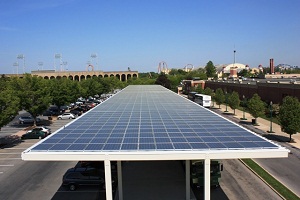Hershey’s gets kisses from the sun
 If you’ve ever been to Hershey’s Park in Pennsylvania, the trams that take you from the expansive parking lot to the amusement park, smell like chocolate, which is enough to celebrate on its own. But now, the chocolate manufacturer is making a concerted effort to become more sustainable, most recently completing solar canopies and electric car charging stations over its parking facilities at Chocolate World.
If you’ve ever been to Hershey’s Park in Pennsylvania, the trams that take you from the expansive parking lot to the amusement park, smell like chocolate, which is enough to celebrate on its own. But now, the chocolate manufacturer is making a concerted effort to become more sustainable, most recently completing solar canopies and electric car charging stations over its parking facilities at Chocolate World.
In all, the company will derive 318 megawatt hours of power a year from the 1,092 module array at the chocolate-maker’s visitor center and the 187 module array at its nearby technical center, said spokesperson Jeff Beckman.
“The canopy provides shade for cars, and under those canopies, we installed Pep electric car charging stations. Two of them,” he said. The chargers each have two solar charging stations. The company purchased the arrays and charger outright, Beckman said.
The Pep car charging stations can be used by visitors to charge their vehicles while enjoying Chocolate World or Hershey’s Park. But they aren’t free. They have credit card readers and charge about $1 an hour to charge a vehicle. The solar canopies can charge a car in about three to four hours.
The installations won’t provide all the energy used at the sites, however. The technical center is Hershey’s WIllie Wonka factory. It’s where Hershey’s cooks, scientists and chocolate engineers develop new treats.
“They have fairly substantial power needs there,” Beckman said. They’re not only figuring out new candies and flavors, they’re also figuring out how to make them at scale. As such they have mixers, coating machines, conveyors, ovens and other high-energy components there, he said.
“The installation is consistent with a number of initiatives we’ve been doing to reduce our impacts on the environment,” Beckman said. In 2010, Chocolate World, which sees more than 3 million visitors annually, achieved negative waste status.
“We achieved negative waste status last year by recycling more volume than we sent to the landfill,” he said.
Hershey’s is also working to educate cacao farmers to help protect the environment. The cacao tree, from which most of Hershey’s products are derived, only grows in certain environments and within a certain range of the equator, according to Beckman.
“There’s a limited number of areas, and production is challenged by rising consumption worldwide and also by disease that challenge the cacao plant,” he said.
The company is also working to reduce packaging and make it more sustainable Beckman said. It’s installed high-efficiency lighting.
“We reduced our energy consumption from lighting by 50 percent,” Beckman said.



